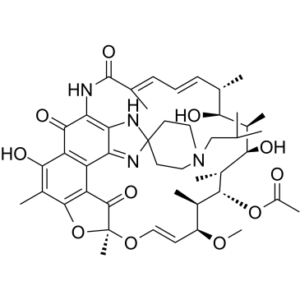Rifabutin (Ansamycin; LM-427)
This product is for research use only, not for human use. We do not sell to patients.

For small sizes, please check our retail website as below: www.invivochem.com
| Size | Price | Stock |
|---|---|---|
| 1g | $325 | In Stock |
| 2g | $520 | In Stock |
| 5g | $875 | In Stock |
Cat #: V5191 CAS #: 72559-06-9 Purity ≥ 98%
Description: Rifabutin (also known as Ansamycin) is a semisynthetic ansamycin and broad-spectrum antibiotic with potent antimycobacterial properties.
Top Publications Citing Invivochem Products
Publications Citing InvivoChem Products
Product Promise

- Physicochemical and Storage Information
- Protocol
- Related Biological Data
- Stock Solution Preparation
- Quality Control Documentation
| Molecular Weight (MW) | 847.00 |
|---|---|
| Molecular Formula | C46H62N4O11 |
| CAS No. | 72559-06-9 |
| Storage | -20℃ for 3 years in powder formr |
| -80℃ for 2 years in solvent | |
| SMILES Code | O=C1c2c(O)c(C)c3c(C4=O)c2C5=NC6(CCN(CC(C)C)CC6)NC5=C1NC(/C(C)=C/C=C/[C@@H]([C@H](O)[C@H]([C@@H](O)[C@H]([C@@H]([C@H](C)[C@@H](OC)/C=C/O[C@]4(O3)C)OC(C)=O)C)C)C)=O |
| Synonyms | Rifabutin; Mycobutin; LM-427; LM 427; LM427; Rifabutina; |
| Protocol | In Vitro | Rifabutin is primarily bactericidal antibiotic drug used to treat tuberculosis. Its effect on bacteria is based on the DNA-dependent RNA polymerase blocking drug rifamycin S., a semi-synthetic derivative. It is effective, for example, in highly resistant mycobacteria, Gram-positive bacteria (and some are effective against Gram-negative bacteria), but also against Mycobacterium tuberculosis, M. leprae, and M. avium intracellulare. Rifabutin is an antibiotic; antitumor. Rifabutin interferes with HSP-90 molecular chaperone, enhances ubiquitination and protein degradation, and inactivates bacterial RNA polymerase. |
|---|
These protocols are for reference only. InvivoChem does not
independently validate these methods.
| Solvent volume to be added | Mass (the weight of a compound) | |||
|---|---|---|---|---|
| Mother liquor concentration | 1mg | 5mg | 10mg | 20mg |
| 1mM | 1.1806 mL | 5.9032 mL | 11.8064 mL | 23.6128 mL |
| 5mM | 0.2361 mL | 1.1806 mL | 2.3613 mL | 4.7226 mL |
| 10mM | 0.1181 mL | 0.5903 mL | 1.1806 mL | 2.3613 mL |
| 20mM | 0.0590 mL | 0.2952 mL | 0.5903 mL | 1.1806 mL |
The molarity calculator equation
Mass(g) = Concentration(mol/L) × Volume(L) × Molecular Weight(g/mol)
Mass
=
Concentration
×
Volume
×
Molecular Weight*
The dilution calculator equation
Concentration(start)
×
Volume(start)
=
Concentration(final)
×
Volume(final)
This equation is commonly abbreviated as: C1 V1 = C2 V2
Concentration(start)
C1
×
Volume(start)
V1
=
Concentration(final)
C2
×
Volume(final)
V2
Step One: Enter information below
Dosage mg/kg
Average weight of animals g
Dosing volume per animal µL
Number of animals
Step Two: Enter the in vivo formulation
%DMSO
+
%
+
%Tween 80
+
%ddH2O
Calculation Results:
Working concentration:
mg/ml;
Method for preparing DMSO master liquid:
mg
drug pre-dissolved in
µL
DMSO(Master liquid concentration
mg/mL)
,Please contact us first if the concentration exceeds the DMSO solubility of the batch of drug.
Method for preparing in vivo formulation:
Take
µL
DMSO master liquid, next add
µL
PEG300, mix and clarify, next add
µL
Tween 80,mix and clarify, next add
µL
ddH2O,mix and clarify.
Note:
- (1) Please be sure that the solution is clear before the addition of next solvent. Dissolution methods like vortex, ultrasound or warming and heat may be used to aid dissolving.
- (2) Be sure to add the solvent(s) in order.




































